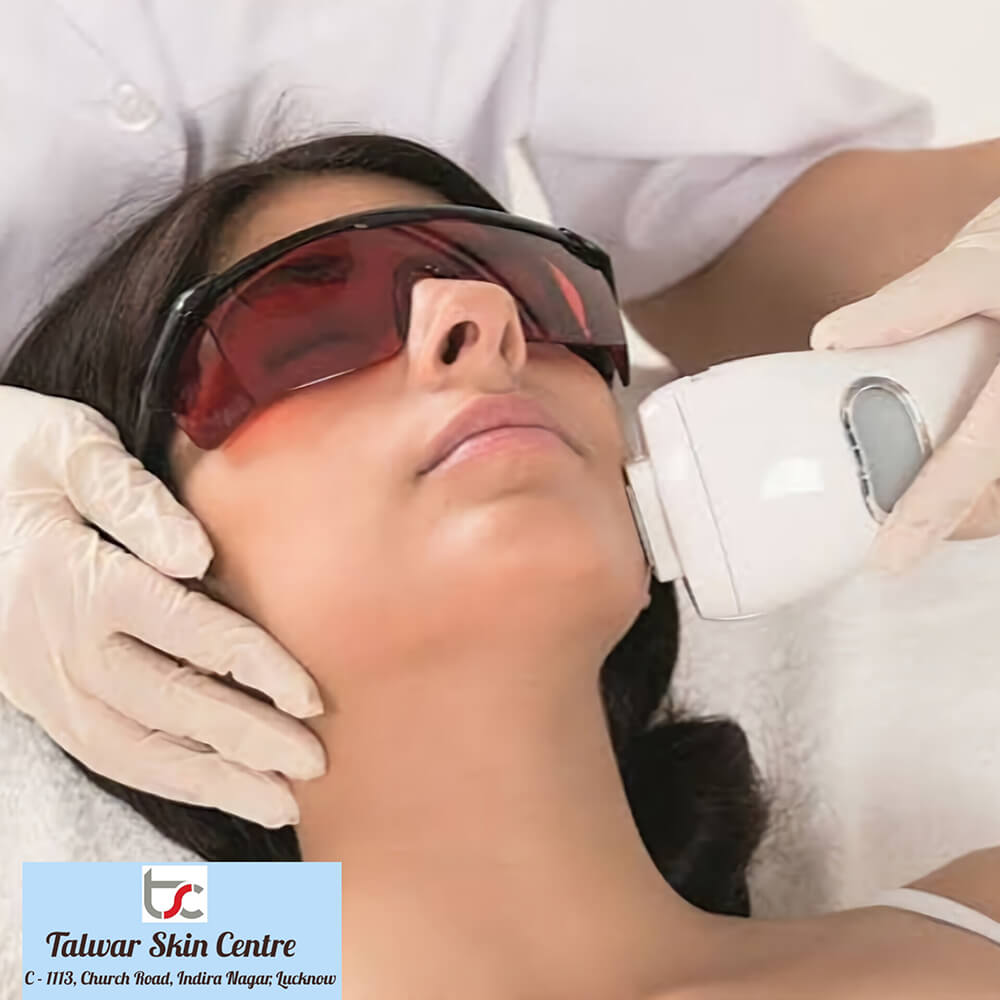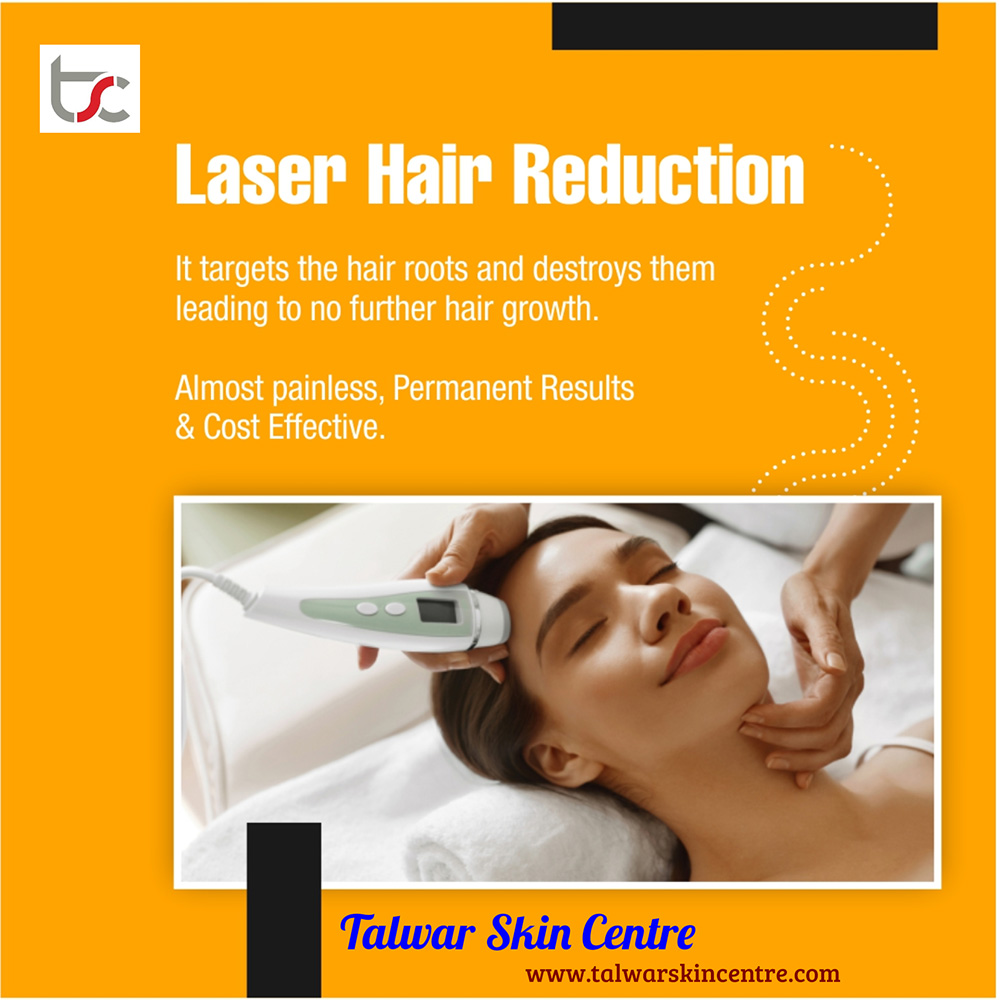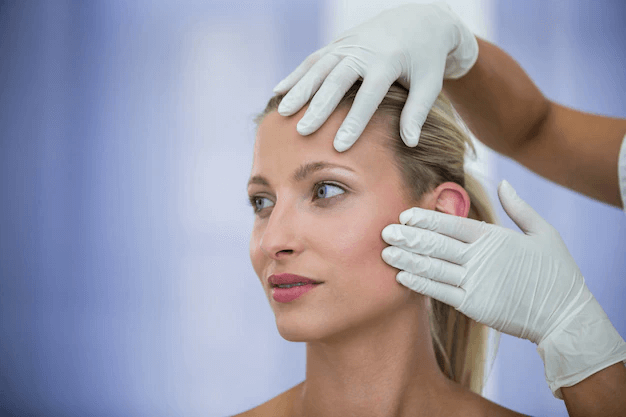Vitiligo: Frequently Asked questions

Vitiligo occurs due to destruction of pigment producing cells in the skin known as melanocytes. These melanocyte cells are responsible for producing the normal body skin color. In the disease vitiligo there is destruction of these melanocyte cells due to the hyperactive immune system and therefore vitiligo is known as an autoimmune disorder.
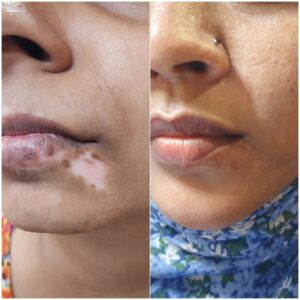
Vitiligo is hereditary in nature in only a very small percentage of patients. It is transmitted from parents to the children in less than 5% of the patients. So therefore the risk of your child developing the disease in case the parents have vitiligo is very less.
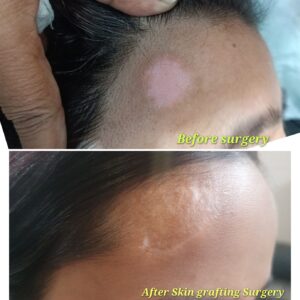
Usually vitiligo is a clinical diagnosis meaning that the diagnosis is made by the treating dermatologist on the basis of clinical and physical examination of the white patch. In early cases where clinical examination is not sufficient a woods lamp examination May be required to establish a firm diagnosis.
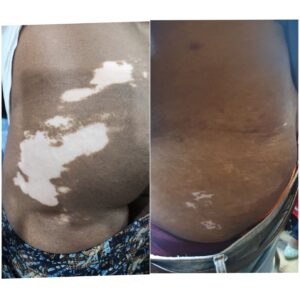
Vitiligo is characterised by the development of a milky white patch due to loss of the normal skin color. These white patches may develop over any part of the body. In children usually such patches are seen over their face and the neck area. In adults these patches may be seen anywhere on the body including lips and the genital area.
These white patches are usually asymptomatic meaning they do not cause any problem to the patient Like itching, pain or burning. Sometimes the hair over the white patch may also become white Which is known as leucotrichia.
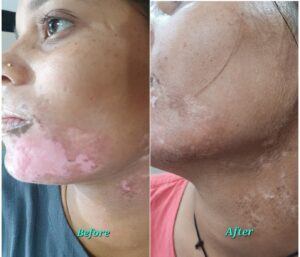
Most Patients go through an initial progressive phase of the disease in which there is a tendency for new white patches to develop with time if no treatment is taken. This progressive phase of the disease may last from few months to couple of years. Once the progressive phase subsidies the disease may enter into a stable phase in which the disease activity stabilises and usually there are no new white patches even if the treatment is stopped. Therefore it is very important to take regular treatment in the initial aggressive phase of the disease to stop new patches from developing.
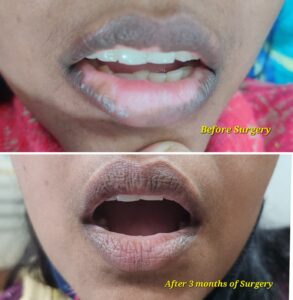
The 3 most common types of vitiligo are:
- Lip tip Vitiligo: This is a type of vitiligo which involves the lip causing loss of pigment over the lip and tips of fingers and toes. This type of vitiligo may also involve the genital area like the penis and nipple an areola region.
- Segmental vitiligo : This type of vitiligo involves only one half of the body and does not spread.onto the other half of body. For example a segmental vitiligo on the face may involve only one side of the face and not the other half of the face.
- Vitiligo Vulgaris : Is this type of vitiligo may involve any part of the body but usually involves the trunk that is the abdomen or the back area.
Treatment of Vitiligo and Leucoderma
What are the various treatment options for vitiligo? What is the best medical treatment for vitiligo?
Vitiligo treatment options aim to restore skin color, slow disease progression, and improve cosmetic appearance. The choice of treatment depends on factors like the extent of depigmentation, stability of the condition, patient preference, and age.
Topical Treatment or creams:
Corticosteroids: Effective for localized vitiligo, especially in early stages. Example: Clobetasol propionate, mometasone, fluticasone, desonide.
Calcineurin Inhibitors: For sensitive areas (face, neck, genitals). Example: Tacrolimus, Pimecrolimus.
Topical Vitamin D Analogues: Often combined with phototherapy. Example: Calcipotriol.
Topical JAK Inhibitors: Newer options like Ruxolitinib and tofacitinib
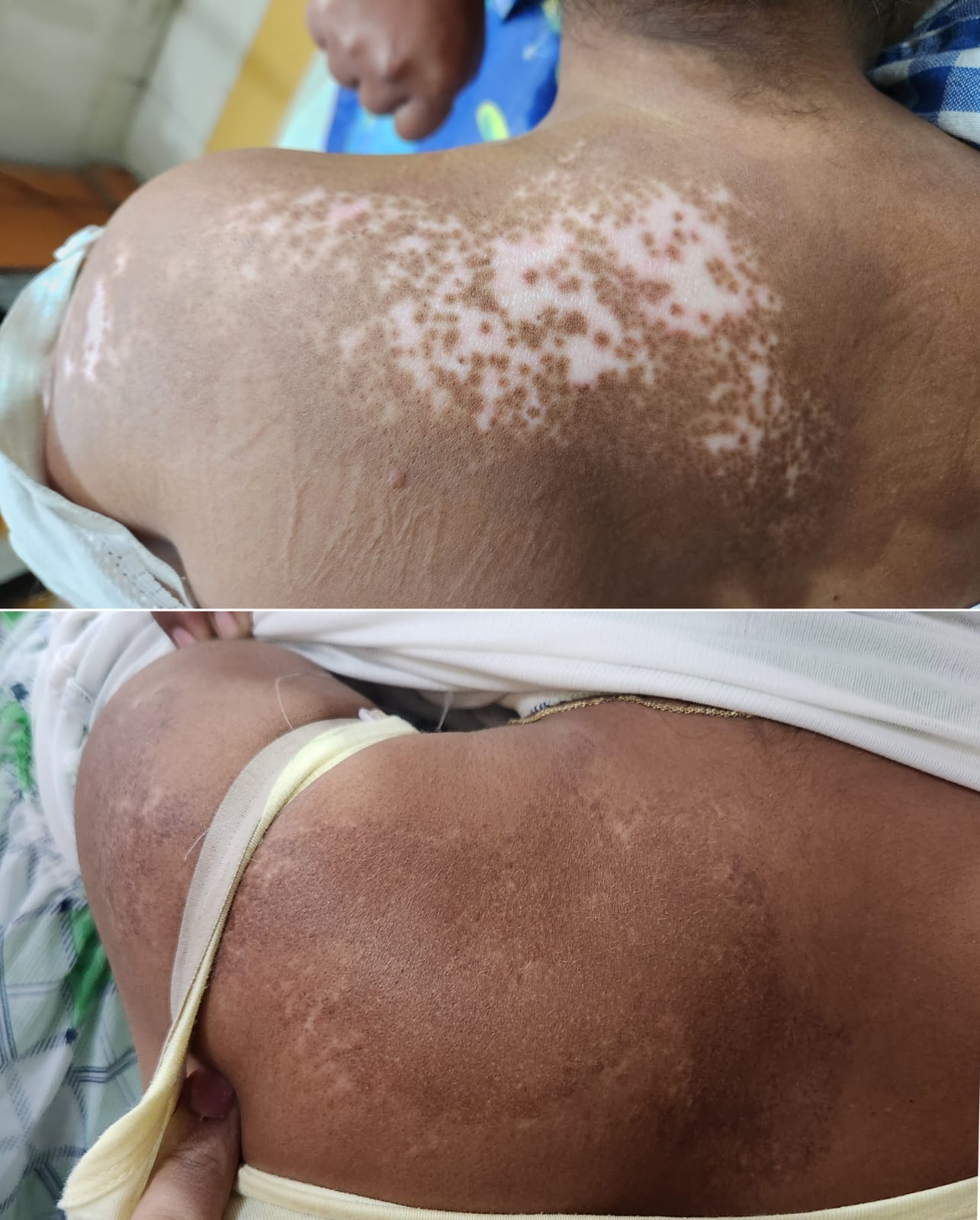
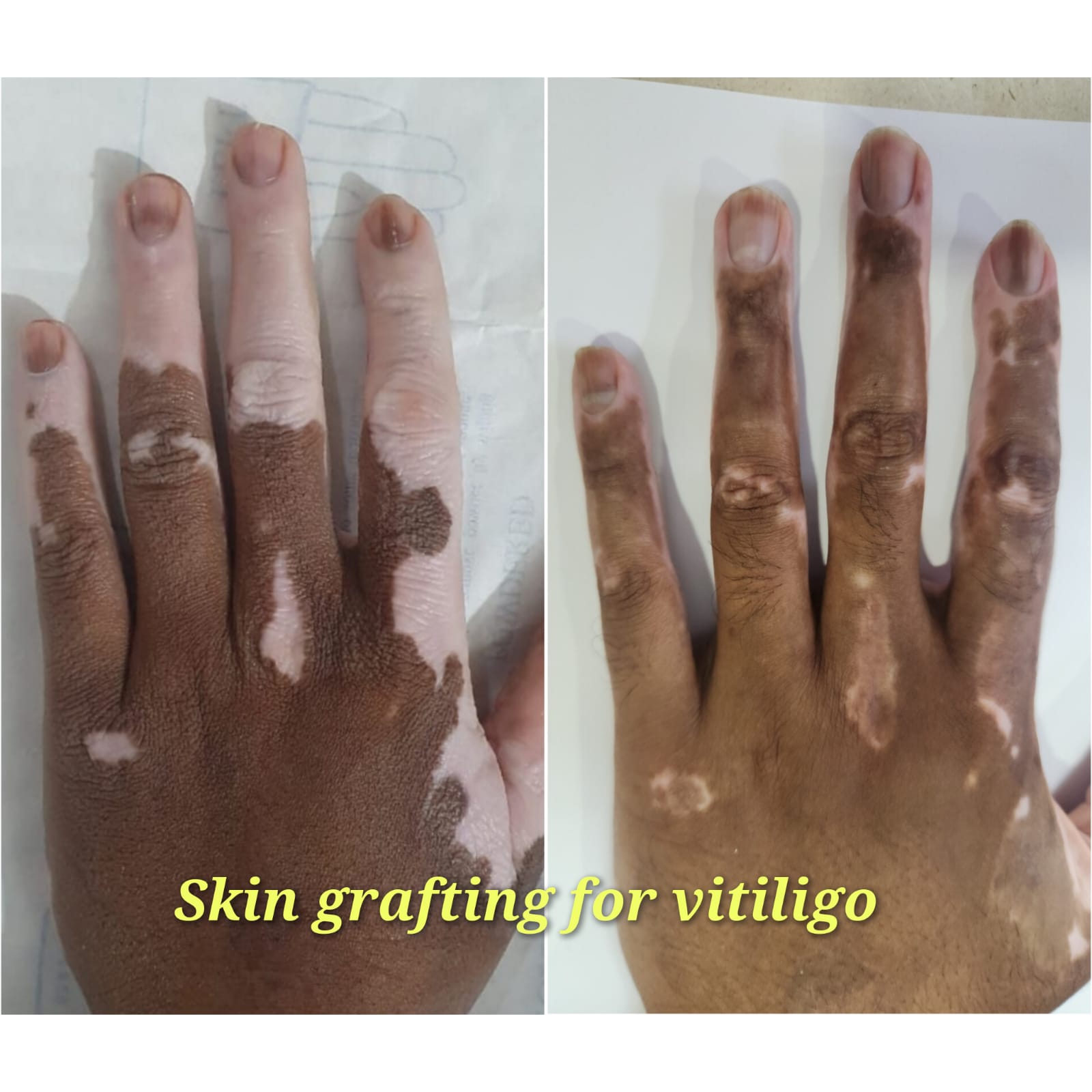
Oral Medications
Oral Steroids: To halt rapid progression (short-term use).
Immunosuppressants: E.g., Methotrexate, Azathioprine, Tofacitinib for severe or refractory cases.
PUVA sol (Psoralen + sunlight exposure)
Phototherapy
Narrowband UVB (NB-UVB): Effective for widespread or generalized vitiligo. Typically requires 2–3 sessions per week for several months.
Immunosuppressants: E.g., Methotrexate, Azathioprine, Tofacitinib for severe or refractory cases.
Excimer Laser (308 nm): Ideal for small, localized patches.
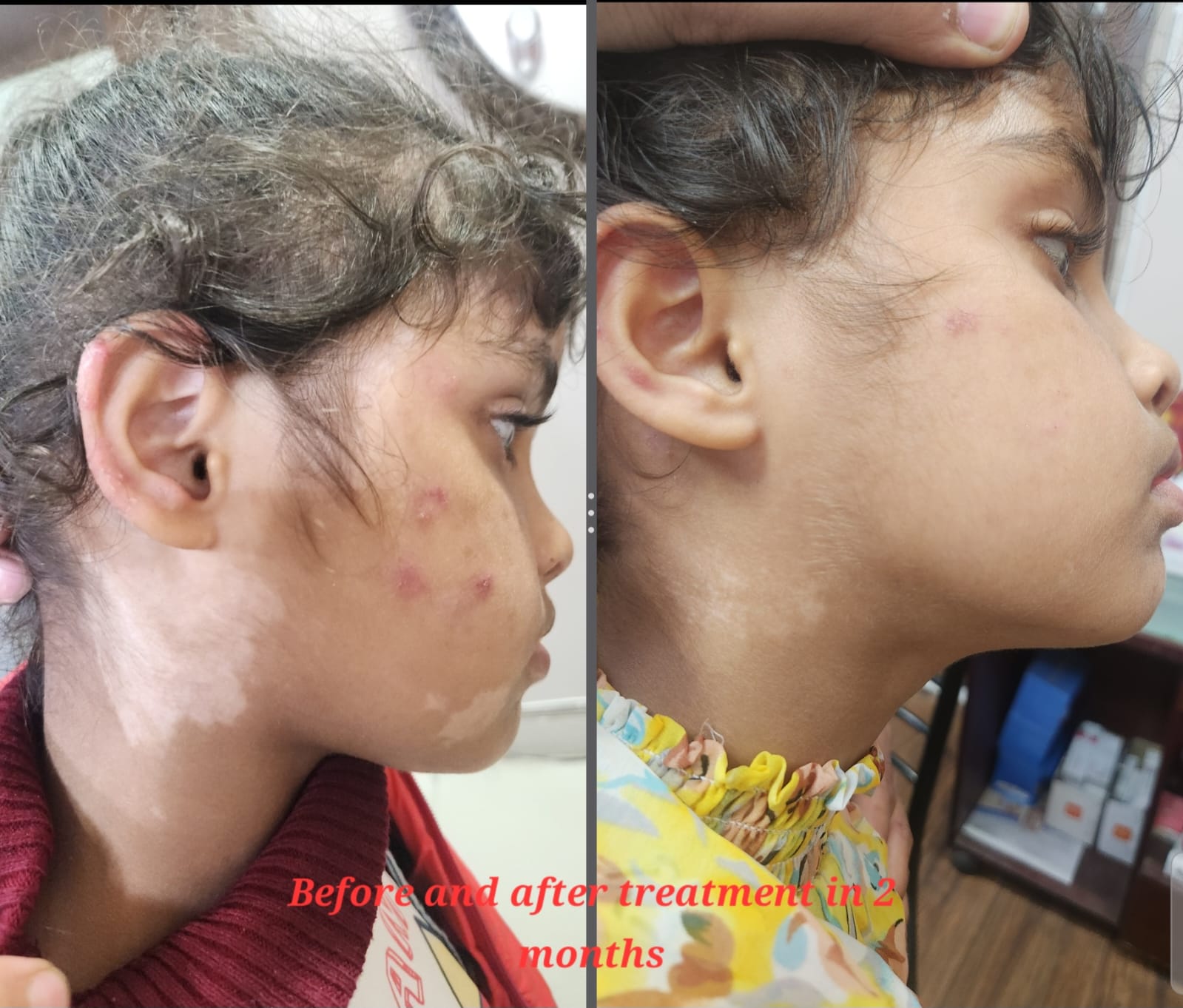
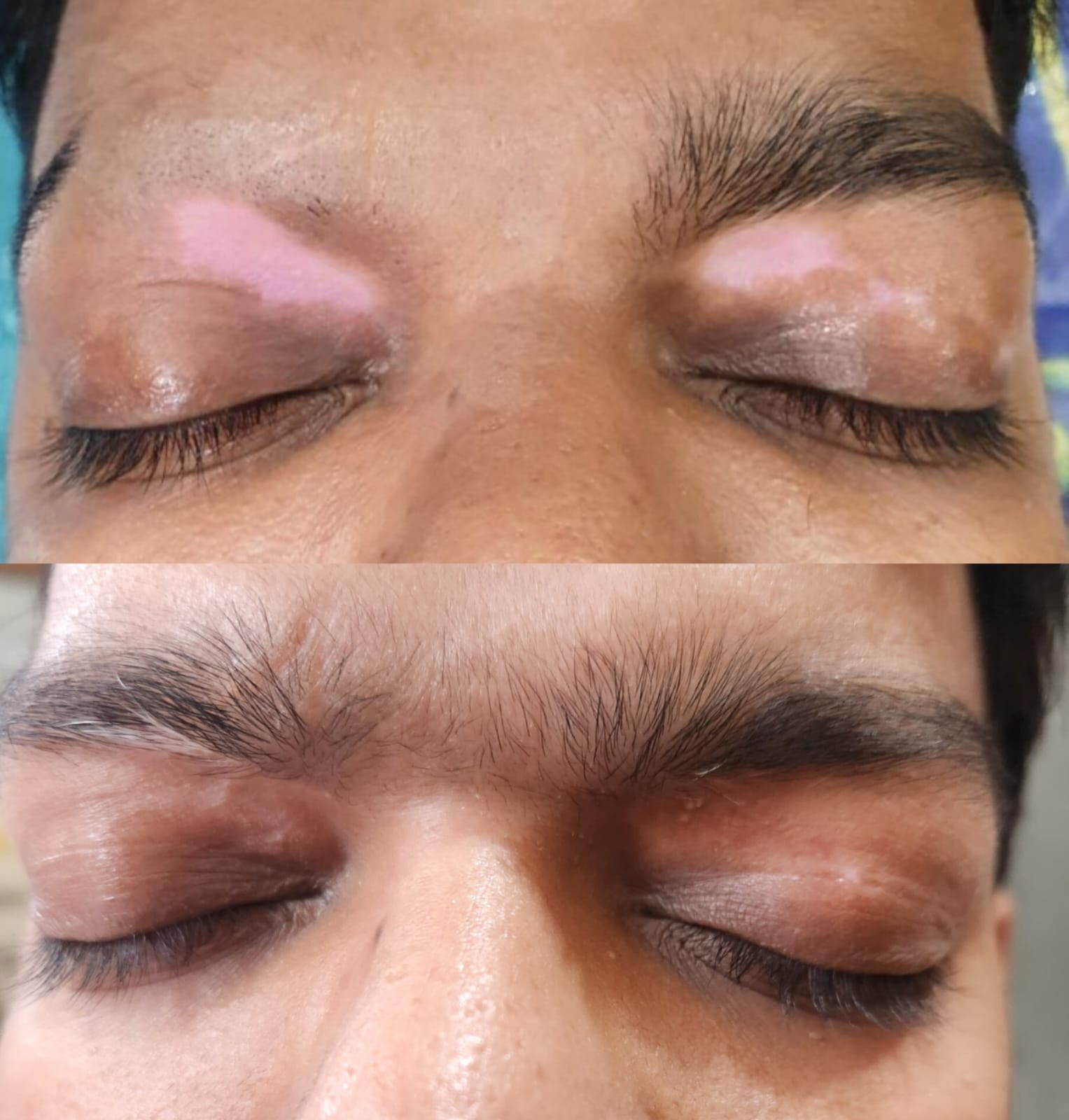
Surgical Treatments
For stable vitiligo (no new patches or progression for at least 1 year)
Skin Grafting: Small patches of healthy skin are transplanted onto depigmented areas. Best for stable, localized vitiligo.
Melanocyte Cell Transplant (Melanocyte-Keratinocyte Transplantation Procedure)
Melanocytes and keratinocytes are harvested, processed, and transplanted to the depigmented area. Suitable for larger patches.
Micropigmentation (Medical Tattooing): Pigments are tattooed into depigmented areas to match skin color. Common for areas like lips and eyebrows.
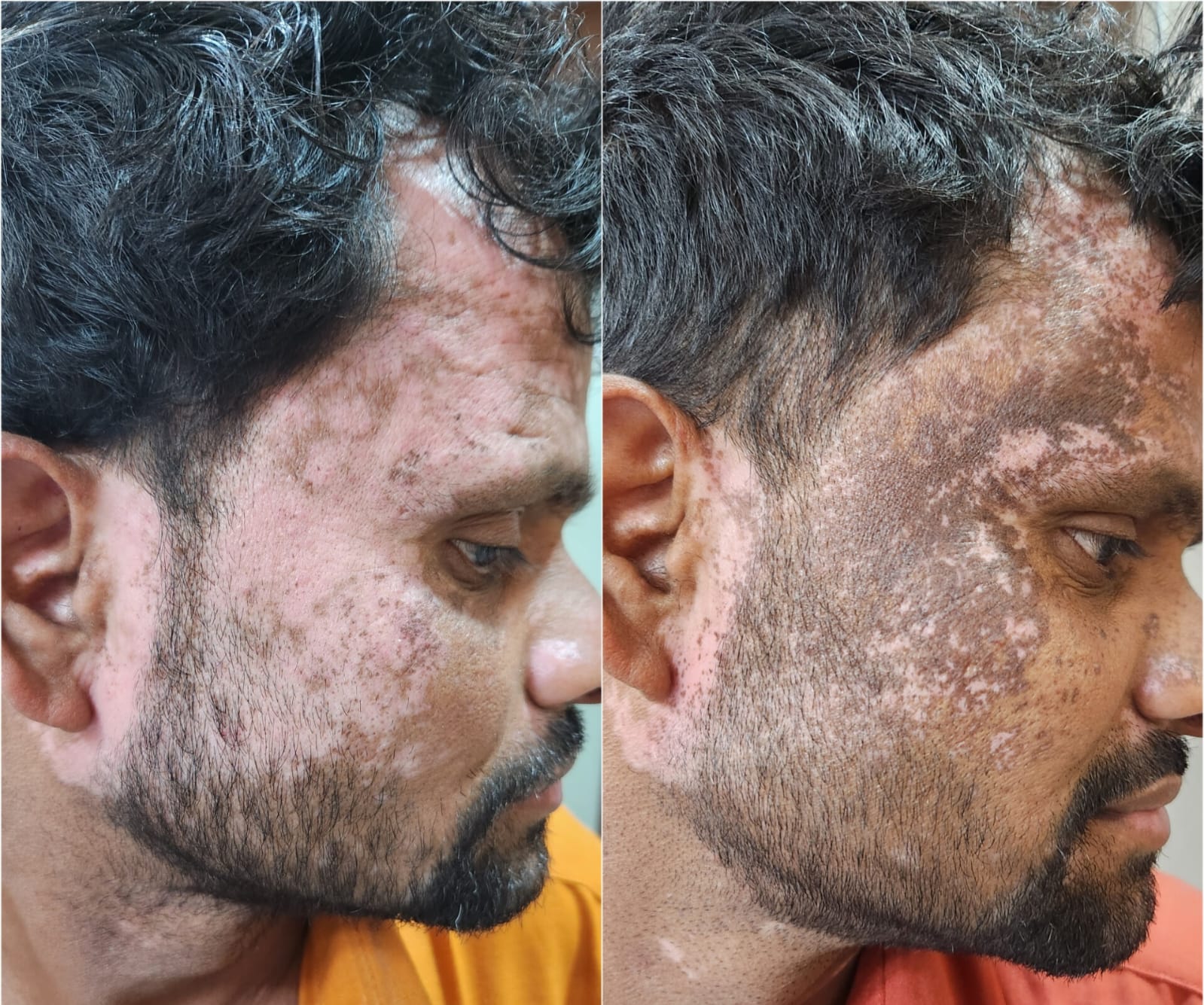
Phototherapy for vitiligo and Leucoderma
What is Narrow band UV -B phototherapy for vitiligo ?
Narrowband phototherapy (Narrowband UVB or NB-UVB) is a widely used treatment for vitiligo that involves exposing the affected skin to a specific wavelength of ultraviolet B (UVB) light, typically around 311–313 nanometers.
This wavelength is considered optimal for treating vitiligo and helps in quickly achieving repigmentation (regaining the colour) of vitiligo patches.
What is the procedure of NBUVB phototherapy for vitiligo?
Patients undergo treatment in a phototherapy chamber which is fitted with specialised UVB tube lights. The duration of each session varies from 2 to 10 minutes and the timing is gradually increased based on the skin’s response. Sessions are usually conducted 2–3 times per week and are painless.
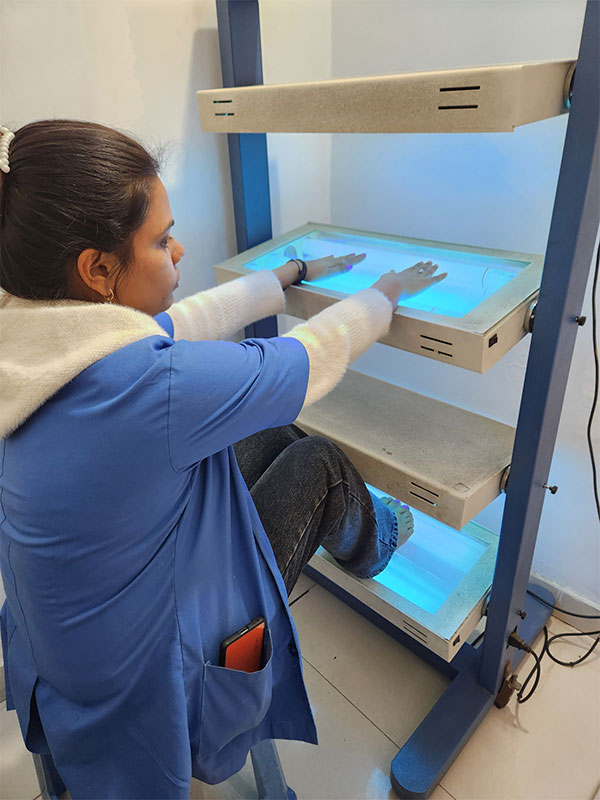
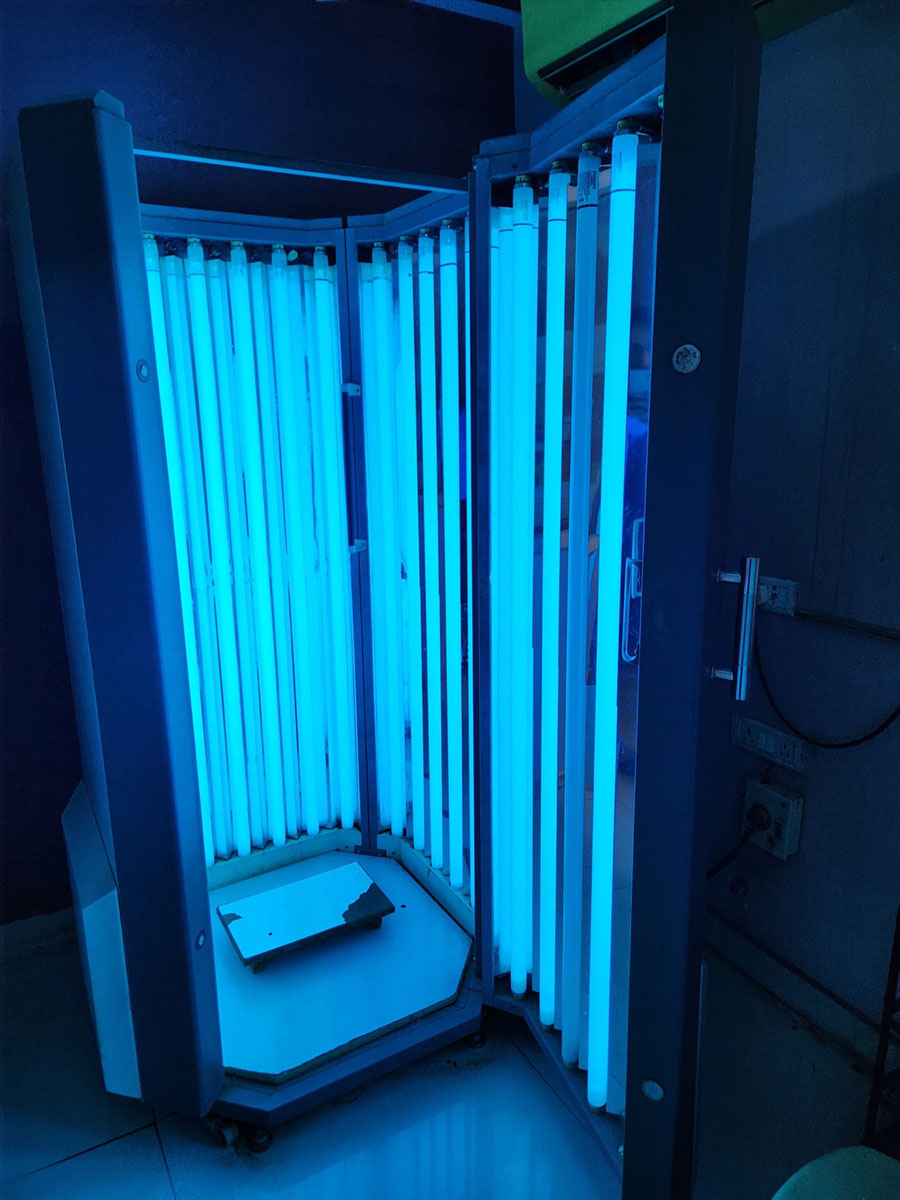
What are the benefits of NBUVB phototherapy for Vitiligo?
NB-UVB is considered a cornerstone of vitiligo treatment. Is is very effective for widespread or localized vitiligo. It is considered Suitable for children and adults alike.
How many sessions of phototherapy are required for repigmentation of vitiligo?
A minimum of 20 to 40 sessions of NBUVB phototherapy are needed for complete repigmentation of vitiligo patches. The number of sessions required depending on the extent of vitiligo disease at presentation.
Are there any side effects of NBUVB phototherapy?
NBUVB phototherapy is considered a very safe treatment option. Mild redness or irritation of the skin may occur during the first few sessions. This usually settles down after a few sessions. Phototherapy is considered one of the safest treatment options for children with vitiligo. Unlike the popular fear, there is NO risk of any cancers with phototherapy.
How long does it take with NBUVB phototherapy to see any visible improvement in vitiligo patches?
Usually it requires 8 to 12 sessions of NBUVB phototherapy to see visible improvement in vitiligo patches. The exact number of sessions required depend on the extent and location of vitiligo.
Where is NBUVB phototherapy treatment available in Lucknow?
NBUVB phototherapy is available at Talwar Skin Clinic, Indira Nagar, Lucknow. It is the only centre in UP with 3 different phototherapy machines which cater to whole body vitiligo, hand foot vitiligo and targeted phototherapy.
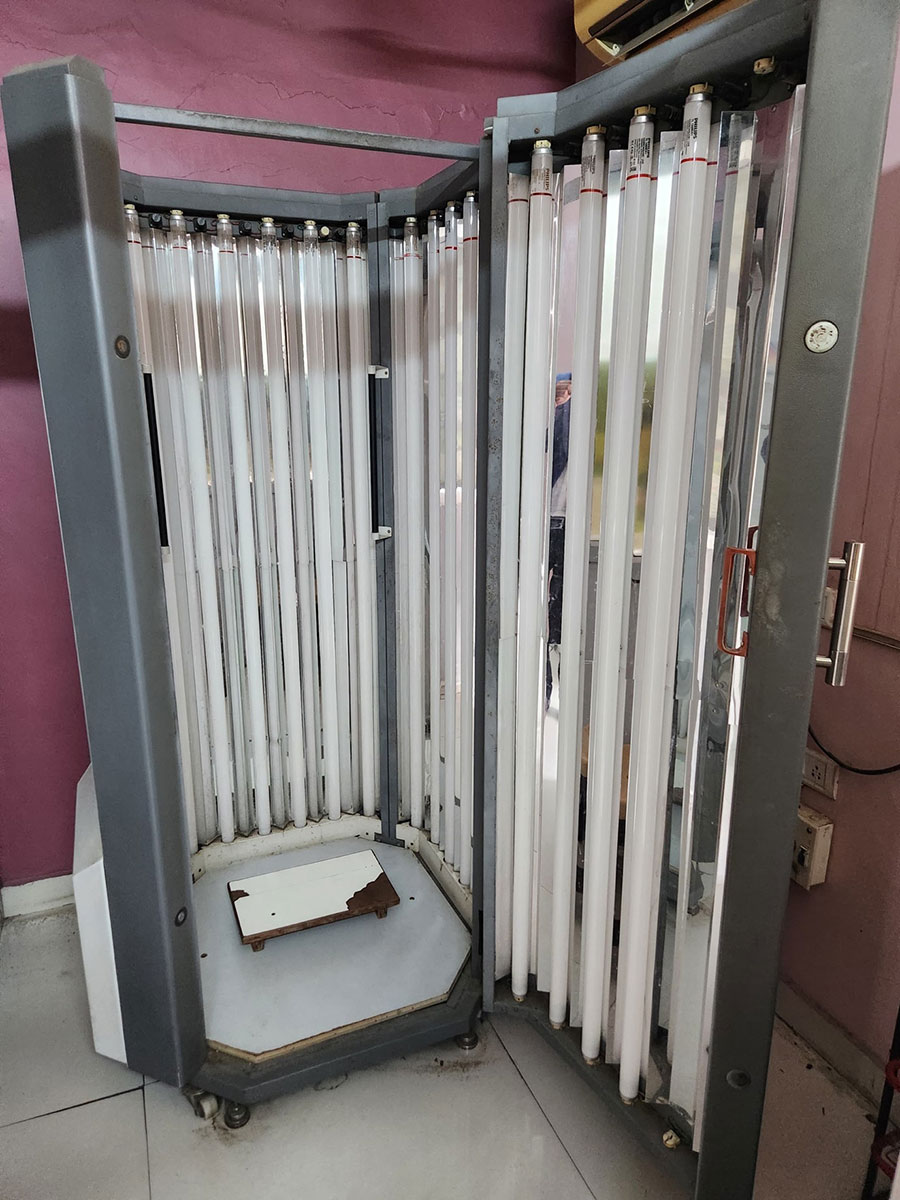
Excimer laser treatment for vitiligo and Leucoderma
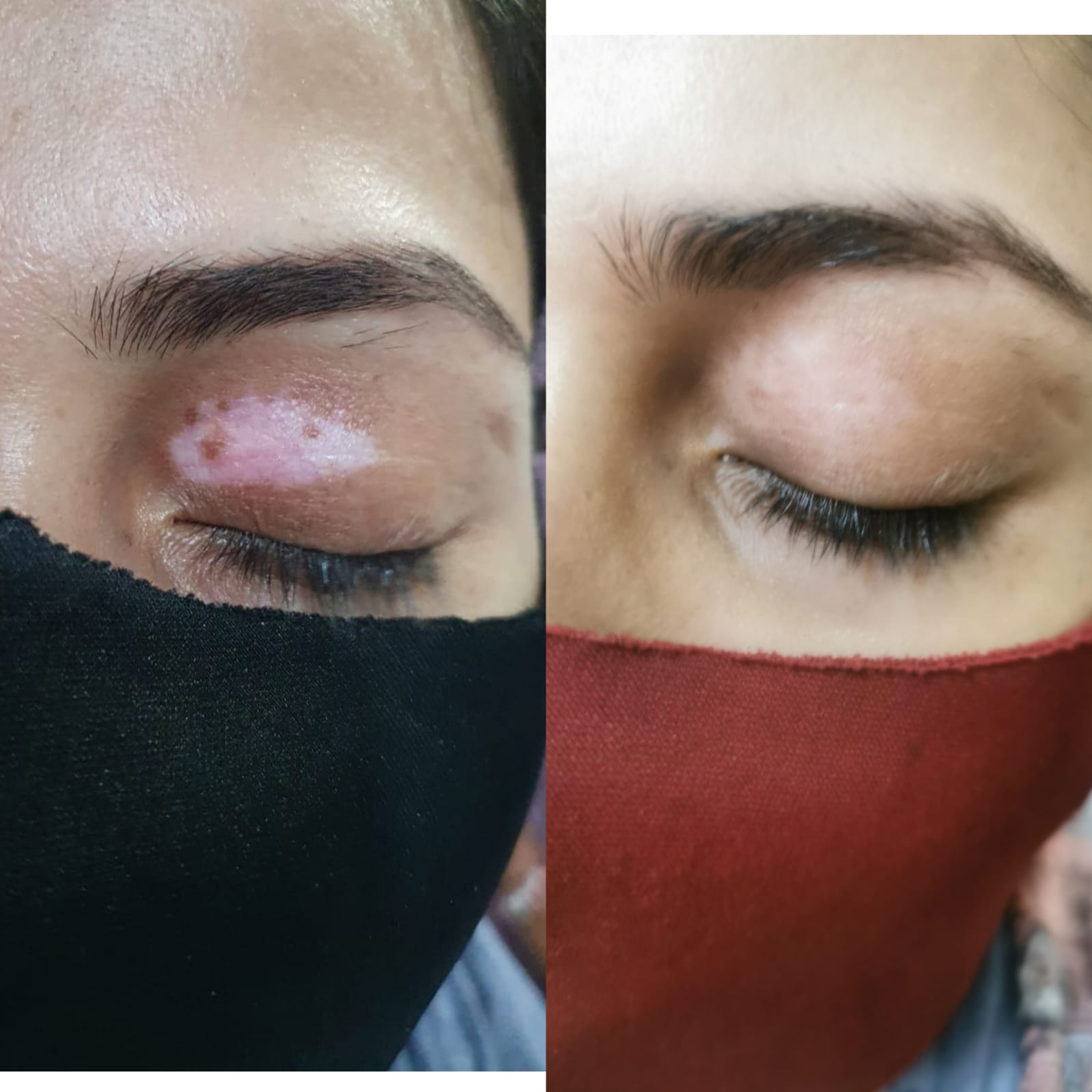
What is Excimer Laser treatment for vitiligo?
An excimer laser is a type of ultraviolet (UV) laser that emits light at a wavelength of 308 nm. It is a targeted phototherapy device that is highly useful for the treatment of vitiligo.
How is excimer laser helpful for Vitiligo?
The excimer laser delivers high-intensity, focused UV light to the affected areas without exposing the surrounding healthy skin.The excimer laser focuses on depigmented patches, stimulating melanocytes (pigment producing cells) in the skin and hair follicles. It enhances the migration and proliferation of melanocytes into the vitiligo patches, aiding in restoring skin color. It is particularly effective for localized vitiligo, including sensitive areas like the face and neck.
How Long Does It Take to See Benefits of excimer laser in vitiligo?
Compared to conventional phototherapy (like NB-UVB), the excimer laser may provide faster repigmentation in small, well-defined patches.Most patients begin noticing repigmentation after 6–12 sessions (usually within 4–6 weeks when performed 2–3 times per week). It may take 20–30 sessions or more for optimal results. The rate of improvement depends on factors such as:
Location of the vitiligo patches (facial areas respond faster than hands and feet).
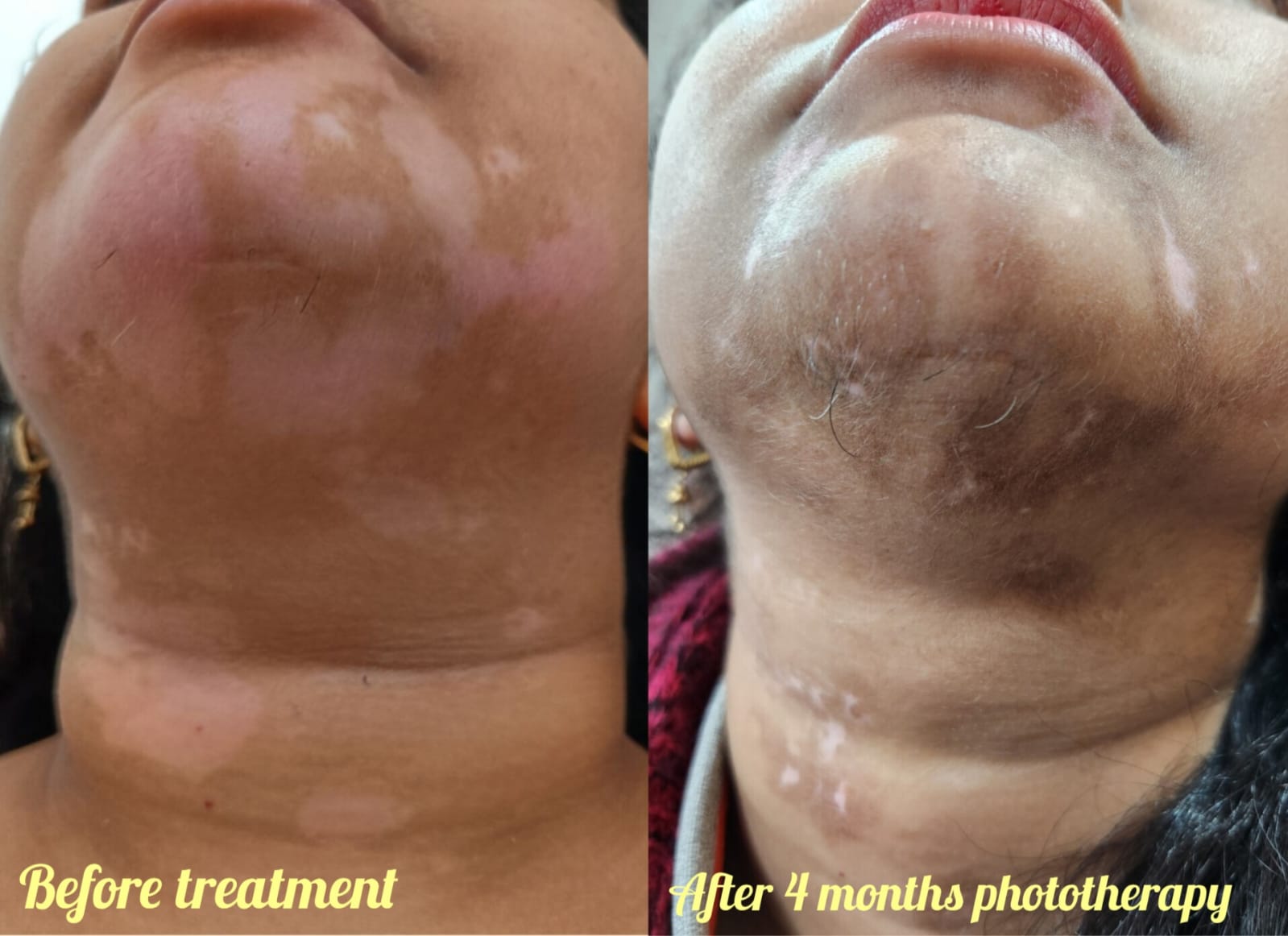
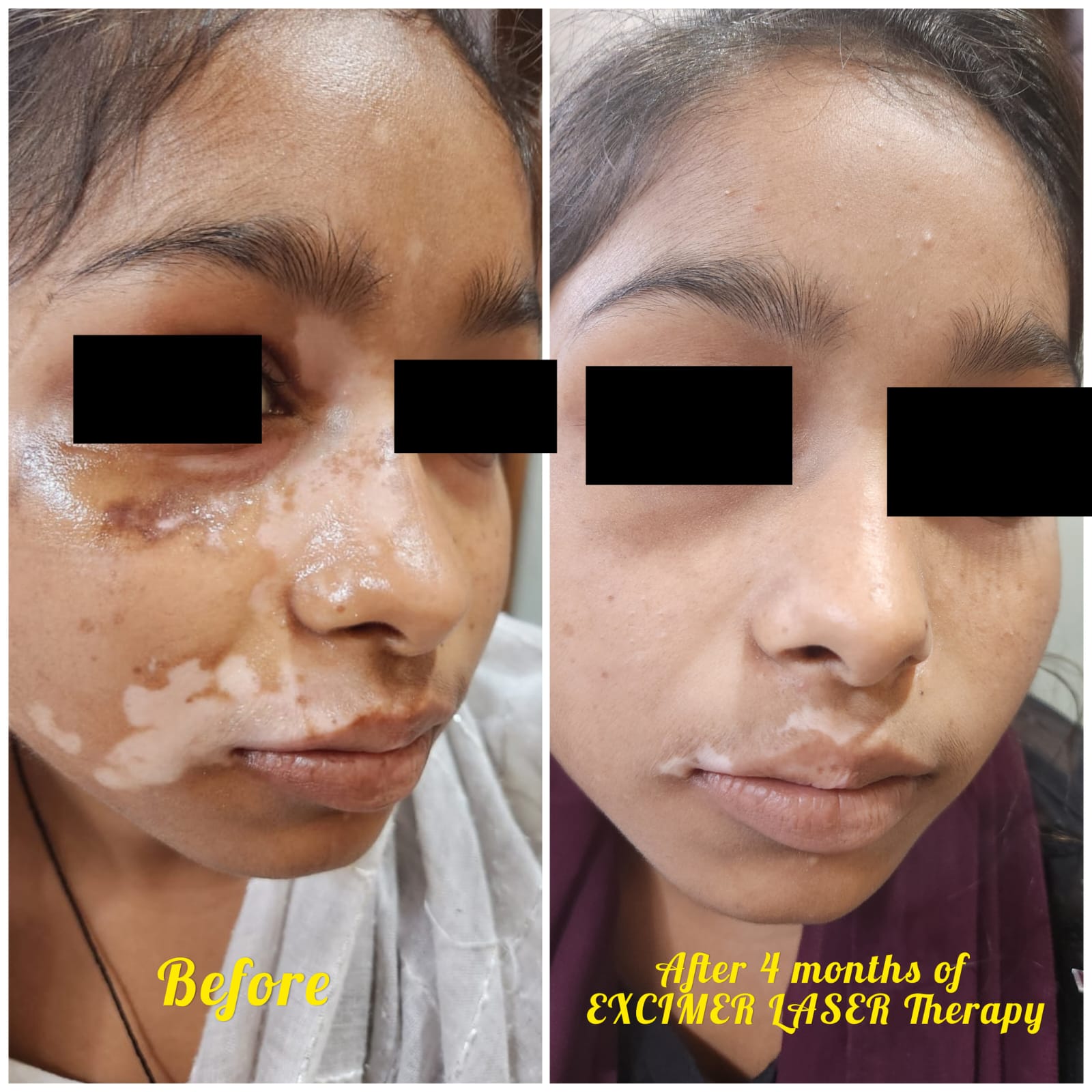
Duration and severity of the condition.
How frequently are the sessions of excimer laser required?
Excimer laser treatment is done usually twice a week. Once optimum results have been achieved , maintenance sessions may be performed once a week only.
Are there any side effects of excimer laser?
While excimer laser is generally safe, some potential side effects include:
1. Redness and Irritation: Temporary erythema or mild skin irritation in the treated area.
2. Hyperpigmentation: Post-inflammatory hyperpigmentation can occur, especially in darker skin types.
3. Limited Effectiveness: In areas with no functional melanocytes (like fingertips), the response may be poor.
4. Burning Sensation: Mild discomfort or burning during or after the procedure.
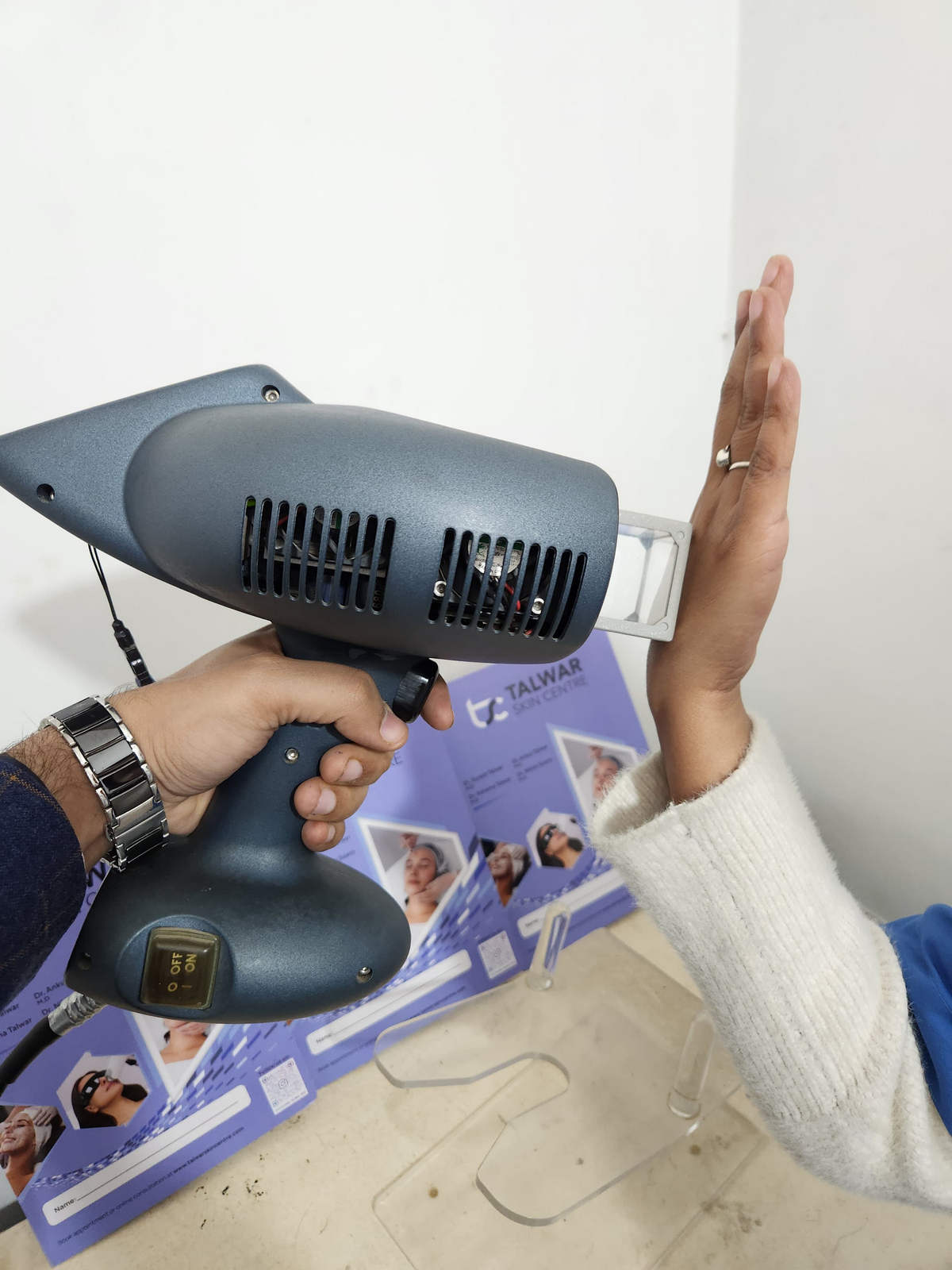
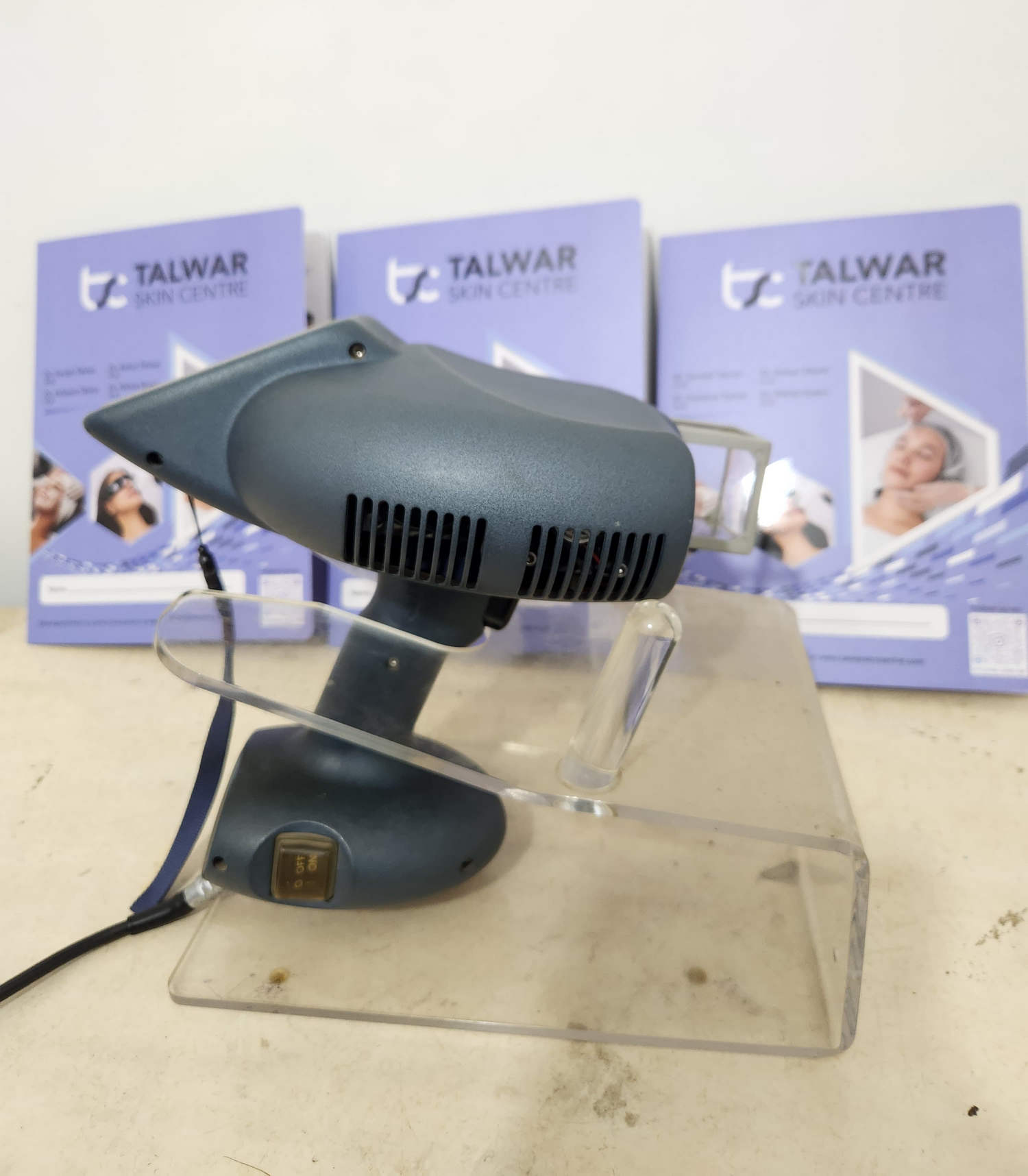
Is excimer laser safe in children?
Excimer laser is a safe and effective option for treating localized vitiligo in children when used appropriately.It is often preferred for pediatric patients with localized vitiligo due to its targeted approach and ability to avoid exposing unaffected skin to UV radiation.
Where is Excimer laser treatment available in Lucknow?
Excimer laser therapy is available at Talwar Skin Clinic at Indira Nagar, Lucknow. We use the latest Alma Excimer laser for best results
Melanocyte Cell Transplant surgery for Vitiligo
What is Melanocyte Cell Transplant Surgery for Vitiligo?
Melanocyte cell transfer surgery, also known as melanocyte-keratinocyte transplantation procedure (MKTP), is a surgical treatment for vitiligo where melanocytes (pigment-producing cells) and keratinocytes (skin cells) are harvested from the patient’s healthy skin, processed, and transplanted to depigmented patches.
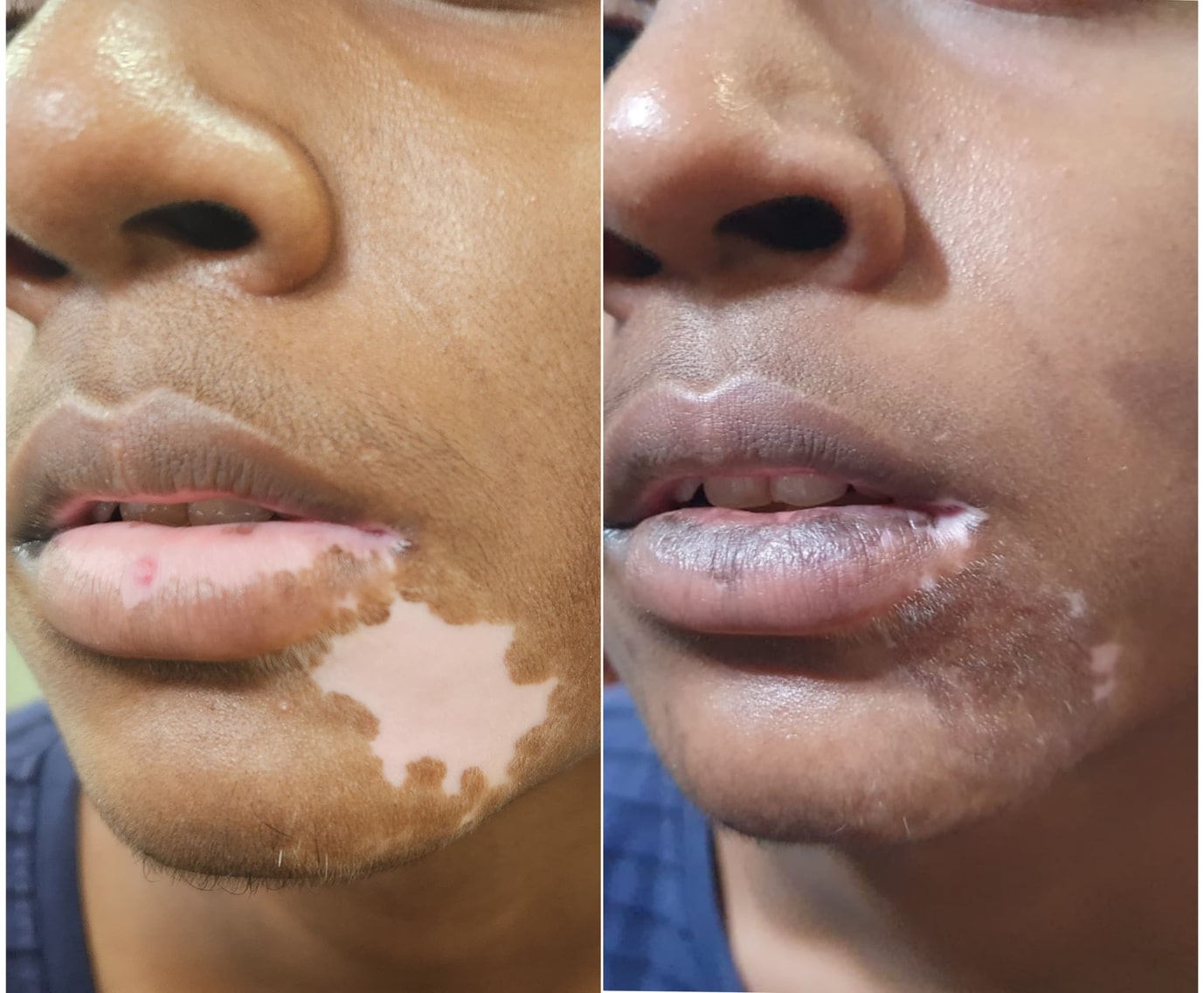
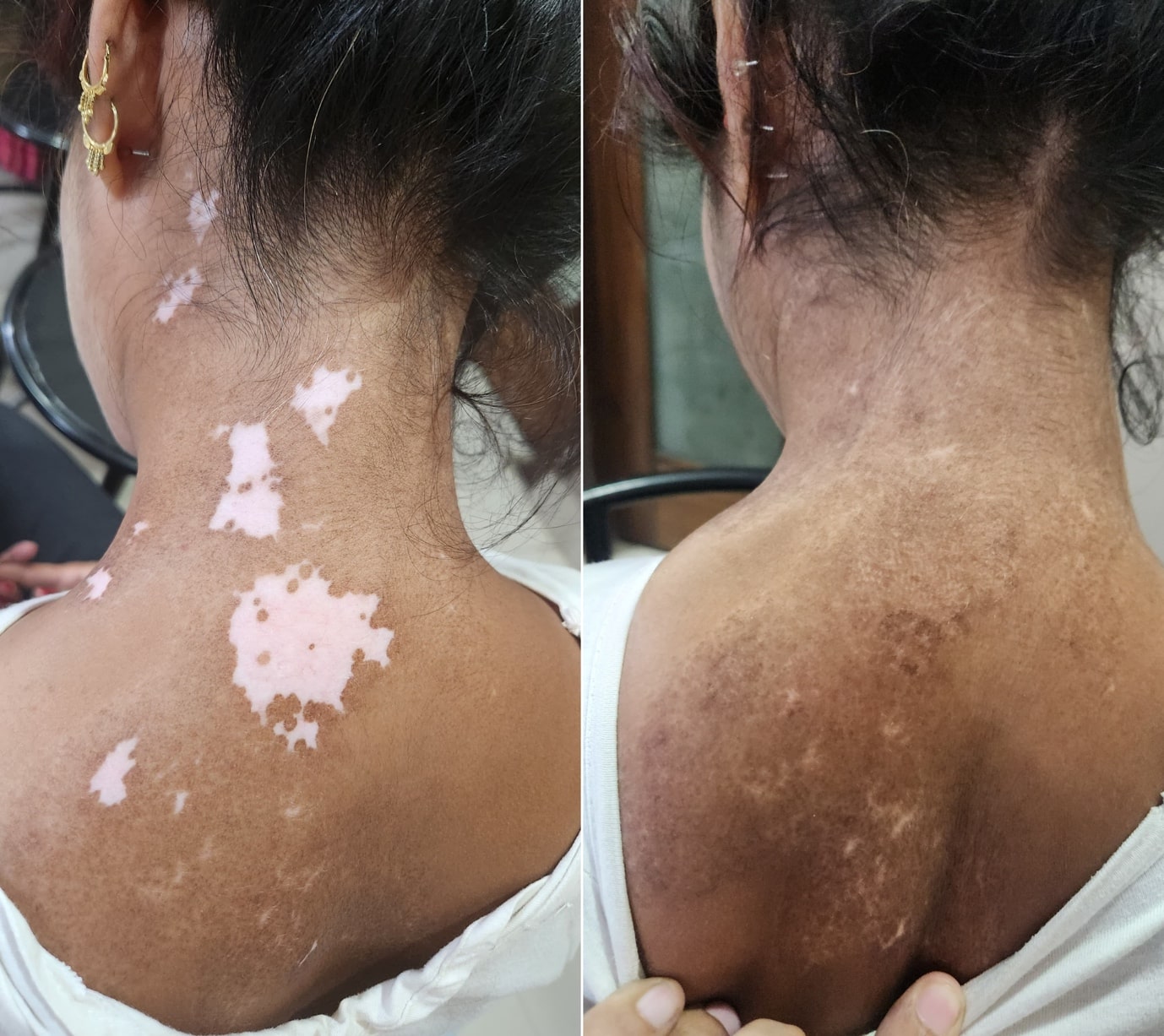
How Effective is Melanocyte Cell Transplant Surgery for Vitiligo?
Repigmentation is seen in 70–90% of cases following melanocyte transplant surgery, depending on factors like the site, stability of vitiligo, and post-operative care.
It is highly effective for stable vitiligo (no new patches or spread for at least 1 year).
Long-lasting Results: Once repigmented, the results are typically permanent as long as the vitiligo remains stable.
What are the benefits to melanocyte transplant surgery?
Melanocyte transplant surgery offers several benefits like it Can treat large depigmented areas in a single session.
Provides natural-looking pigmentation since the patient’s own melanocytes are used.
Minimizes scarring compared to older grafting techniques.
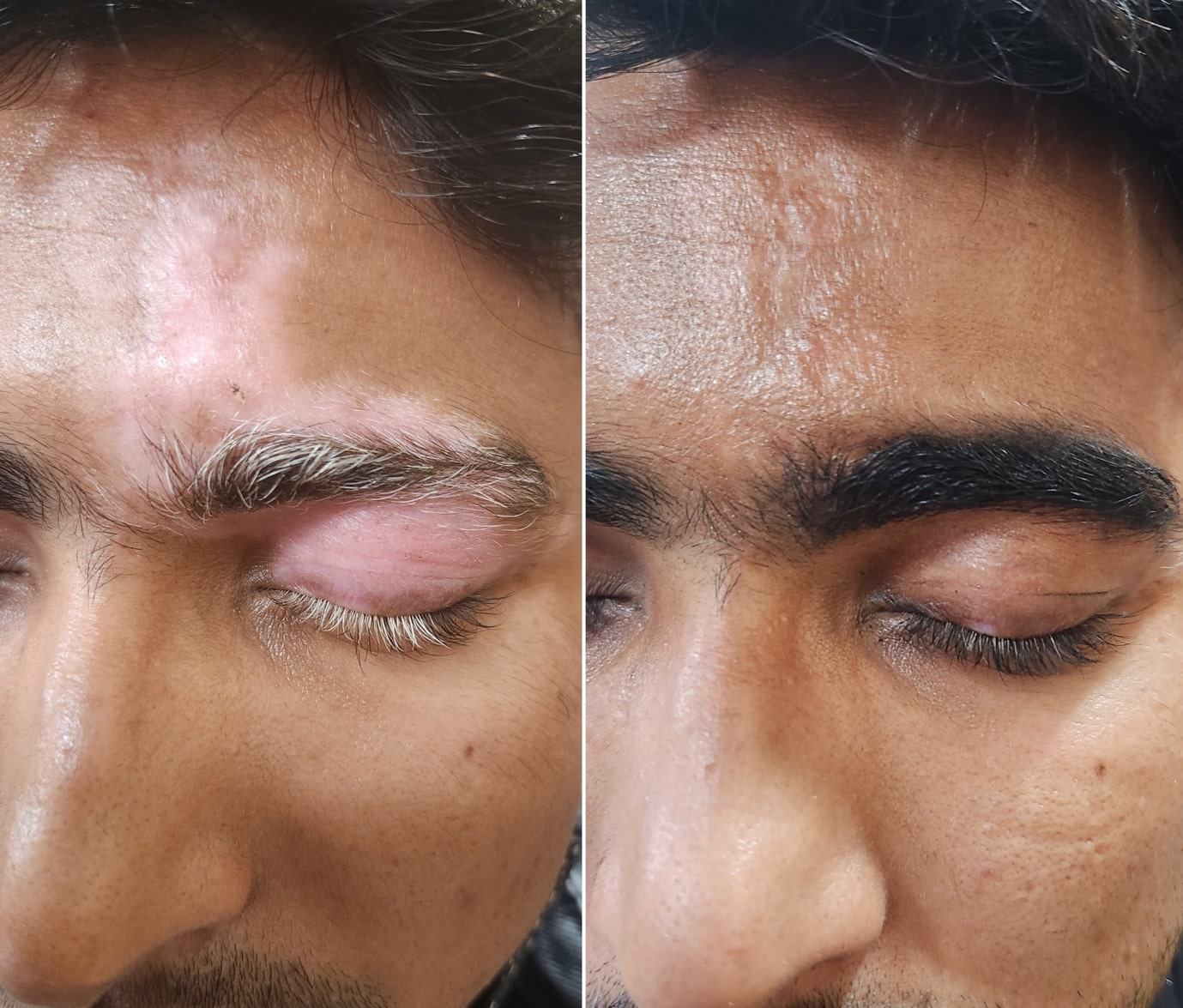
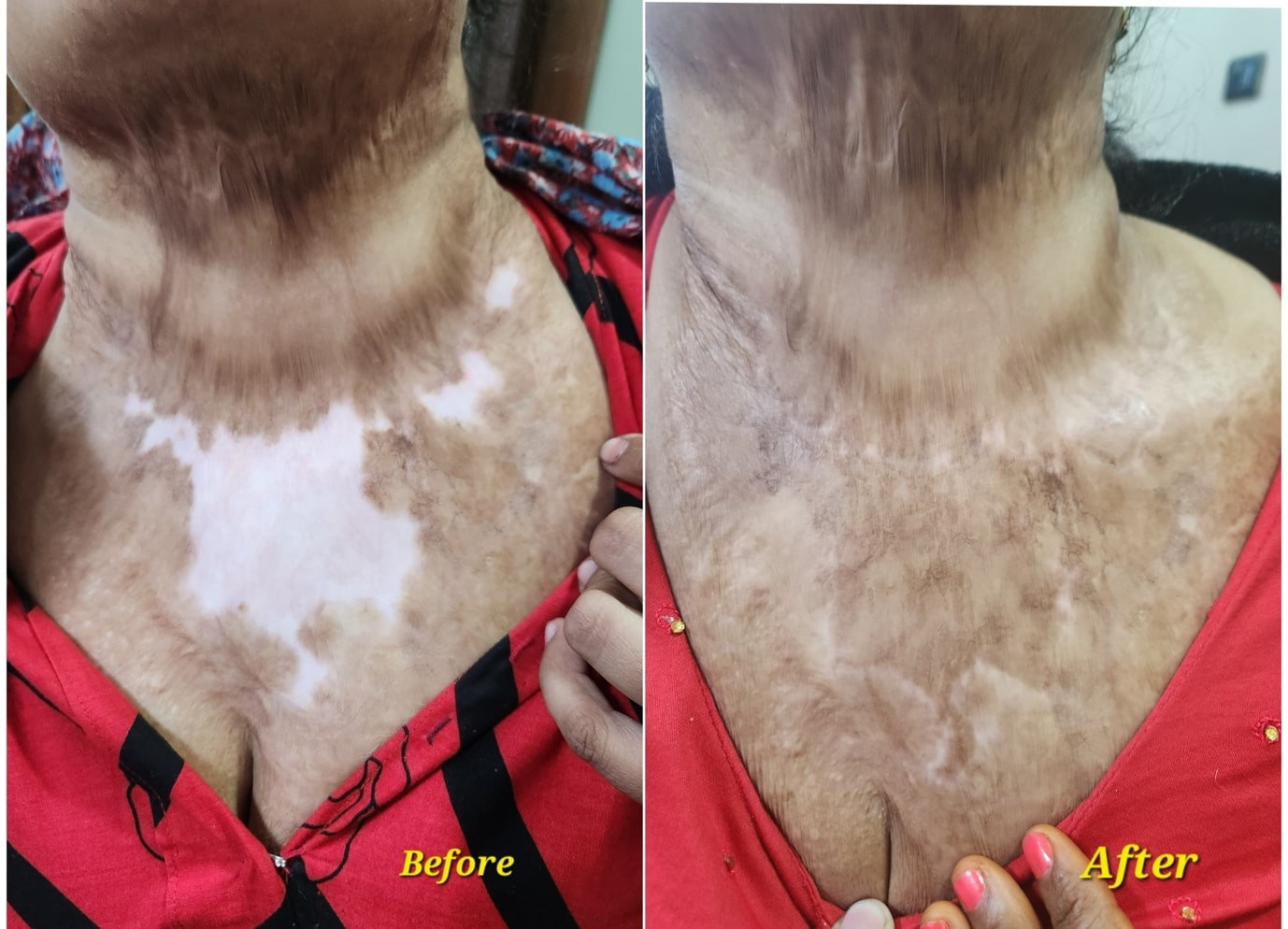
Which Areas are Best Suited for Melanocyte Cell Transplant Surgery?
Melanocyte cell transfer surgery works best on areas where Hair Follicles are Present. These Hair follicles act as reservoirs for melanocytes, improving repigmentation (e.g., face, neck, trunk).
Hands, feet, and fingertips are less responsive due to fewer hair follicles and poor melanocyte migration.Lips and genitals can respond, but the success rate is variable.
How long is the procedure of melanocyte cell transplant surgery?
The melanocyte cell transplant surgery may take 4 to 5 hours. There is no need for any admission and the patient is free to go home on the same day. The procedure is performed under local anaesthesia only and the surgery is largely painless.
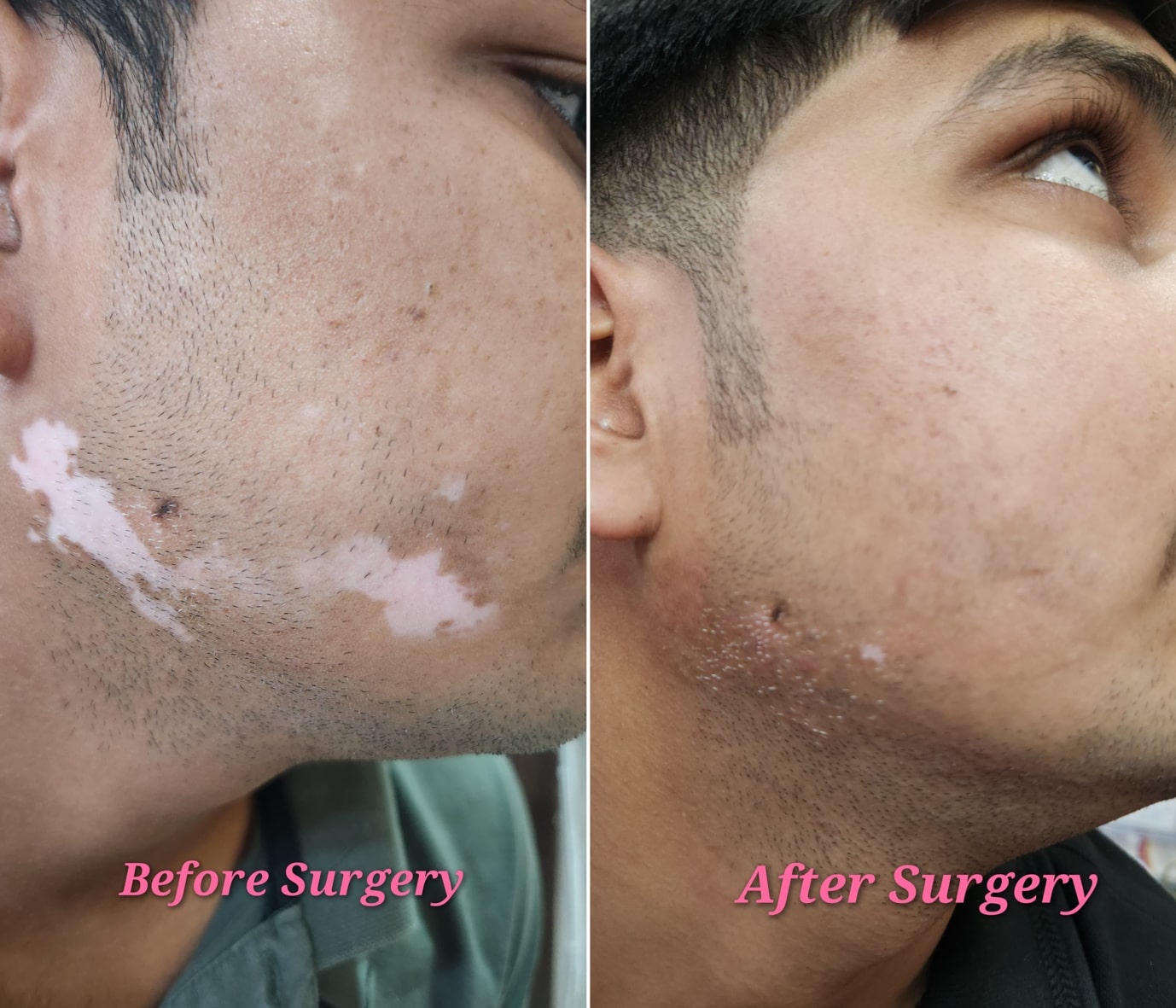
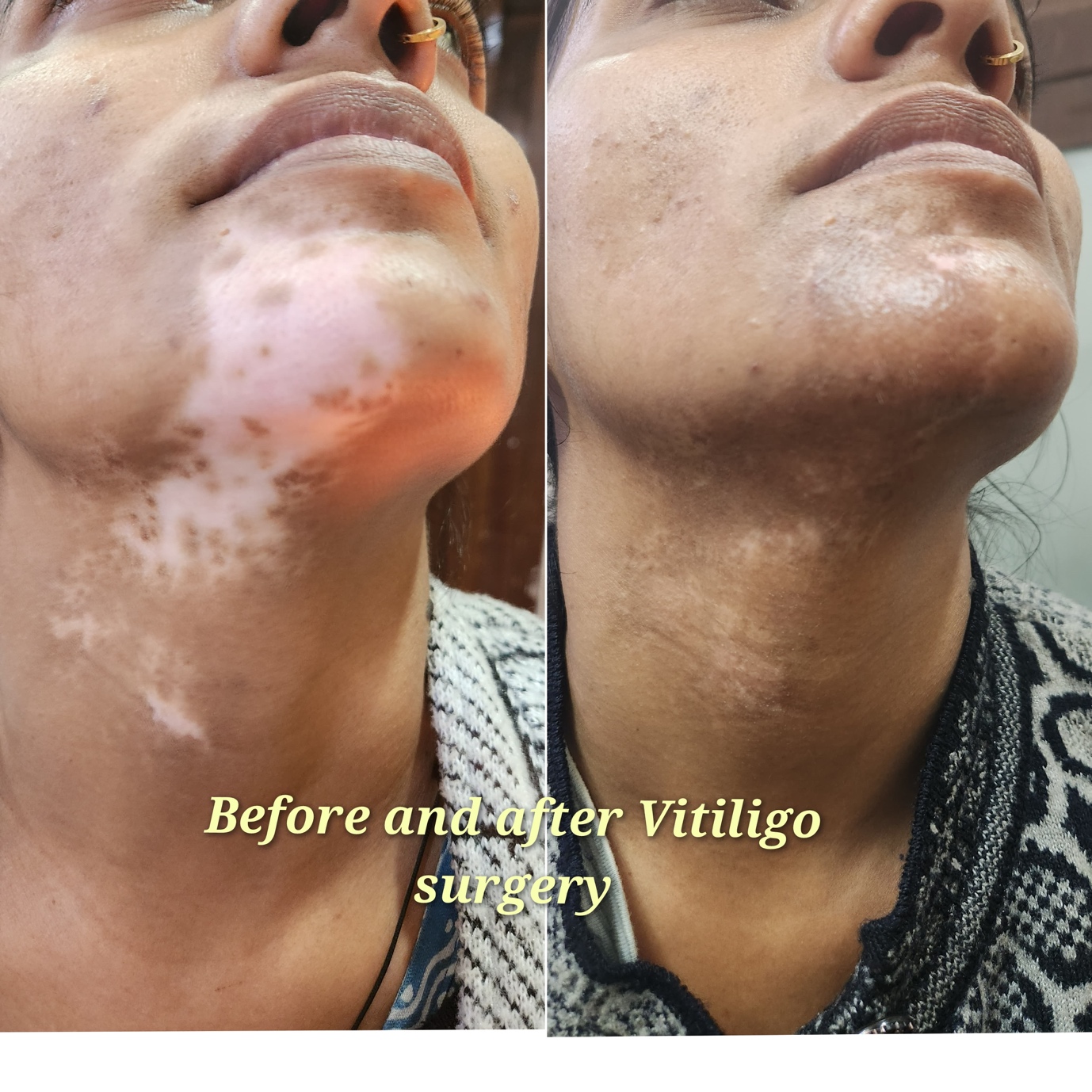
How long does it take to see the results of melanocyte cell transplant surgery ?
The results of melanocyte cell transplant surgery for vitiligo typically take 3 to 6 months to become noticeable. There are 4 phases following melanocyte transplant surgery:
1. Initial Healing (1–2 Weeks): The transplanted area heals, and the protective dressing is removed.
2. Onset of Repigmentation (4–8 Weeks): New pigment begins to appear in the treated area, usually as small islands.
3. Significant Repigmentation (3–6 Months): Pigmentation gradually spreads and becomes more uniform. The area starts to blend with the surrounding skin.
4. Full Results (6–12 Months): In most cases, full repigmentation is achieved within this period.
Where is melanocyte cell transplant surgery available in Lucknow?
Melanocyte cell transplant surgery is performed routinely at Talwar Skin Clinic, Indira nagar, Lucknow. We have successfully performed more than 2000 cases of melanocyte transplant surgery for vitiligo.

